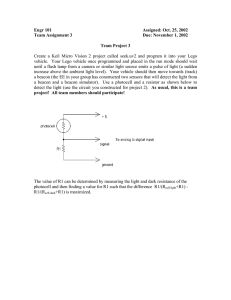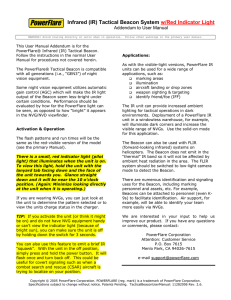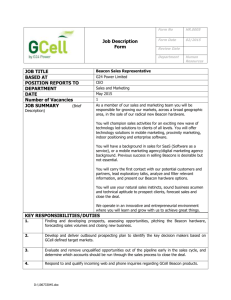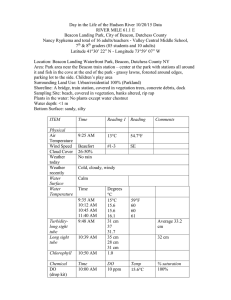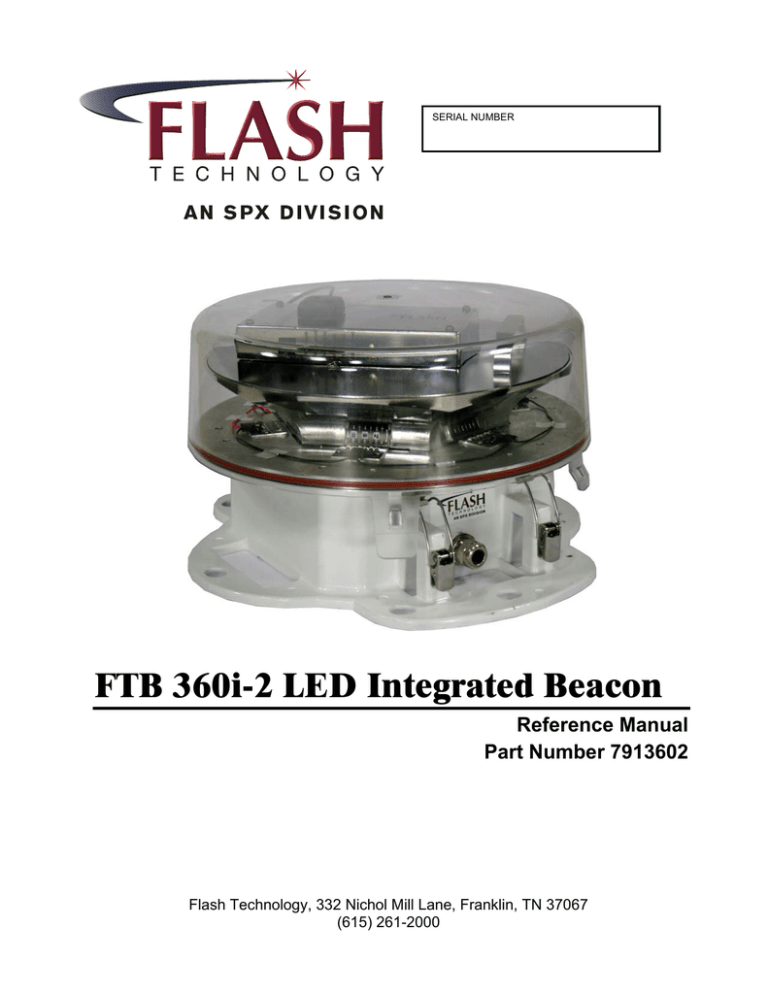
SERIAL NUMBER
FTB 360i-2 LED Integrated Beacon
Reference Manual
Part Number 7913602
Flash Technology, 332 Nichol Mill Lane, Franklin, TN 37067
(615) 261-2000
Front Matter
Abstract
This manual contains information and instructions for installing, operating and maintaining the
FTB 360i-2 LED Integrated L-864 Beacon.
Copyright
Copyright © 2010, Flash Technology®, Franklin, TN, 37067, U.S.A.
All rights reserved. Reproduction or use of any portion of this manual is prohibited without
express written permission from Flash Technology and/or its licenser.
Trademark Acknowledgements
Flash Technology® is a registered trademark name.
ElectroFlash™, Flash Tech™, Flash Technology™, FTCA™, Flash™ and the Flash Technology
Logo are all trademarks of Flash Technology.
All trademarks and product names mentioned are properties of their respective companies and are
recognized and acknowledged as such by Flash Technology.
Disclaimer
While every effort has been made to ensure that the information in this manual is complete,
accurate and up-to-date, Flash Technology assumes no liability for damages resulting from any
errors or omissions in this manual, or from the use of the information contained herein. Flash
Technology reserves the right to revise this manual without obligation to notify any person or
organization of the revision.
In no event will Flash Technology be liable for direct, indirect, special, incidental, or
consequential damages arising out of the use of or the inability to use this manual.
Warranty
Flash Technology warrants all components, under normal operating conditions, for 5 years.
ii
Revision 1 – 5/7/2010
FTB 360i-2
Personnel Hazard Warning
Dangerous Voltages
Dangerous line voltages reside in certain locations in this equipment. Also, this equipment may
generate dangerous voltages. Although Flash Technology has incorporated every practical safety
precaution, exercise extreme caution at all times when you expose circuits and components, and
when you operate, maintain, or service this equipment.
Avoid Touching Live Circuits
Avoid touching any component or any part of the circuitry while the equipment is operating. Do
not change components or make adjustments inside the equipment with power on.
Do Not Depend on Interlocks
Never depend on interlocks alone to remove unsafe voltages. Always check circuits with a
voltmeter after turning the circuit breakers off. Under no circumstances remove or alter the
wiring or interlock switches.
FTB 360i-2
Revision 1 – 5/7/2010
iii
Table of Contents
FTB 360i-2 LED Integrated Beacon....................................................................................................i Front Matter ....................................................................................................................................... ii Abstract .......................................................................................................................................... ii Copyright ....................................................................................................................................... ii Trademark Acknowledgements ..................................................................................................... ii Disclaimer ...................................................................................................................................... ii Warranty ........................................................................................................................................ ii Personnel Hazard Warning ............................................................................................................... iii Dangerous Voltages ...................................................................................................................... iii Avoid Touching Live Circuits ...................................................................................................... iii Do Not Depend on Interlocks ....................................................................................................... iii Table of Contents ...............................................................................................................................iv List of Figures ..................................................................................................................................... v List of Tables ...................................................................................................................................... v Section 1 - Overview .......................................................................................................................... 1 Section 1.1 Beacon Component Identification ............................................................................... 2 Section 2 – Installation – Mounting, Wiring, and Checkout .............................................................. 5 2.1 Mounting the Beacon ................................................................................................................ 5 2.2 Wiring the Beacon .................................................................................................................... 7 2.3 Verifying Operation .................................................................................................................. 7 2.3.1 Power up ............................................................................................................................ 7 2.3.2 Synchronization Underway ............................................................................................... 8 2.3.3 Synchronization Complete................................................................................................. 8 Section 3 - Operation .......................................................................................................................... 9 3.1 Indicators and Configuration .................................................................................................... 9 Section 4 - Beacon Theory of Operation .......................................................................................... 10 4.1 System Overview .................................................................................................................... 10 Section 5 - Maintenance and Troubleshooting ................................................................................. 12 5.1 Maintenance ............................................................................................................................ 12 5.2 Troubleshooting ...................................................................................................................... 13 5.3 Beacon Repair Procedures ...................................................................................................... 14 5.3.1 Replacing the Controller Assembly (11000010471) ....................................................... 14 5.3.2 Replacing the Power Supply (11000010303) .................................................................. 15 5.3.3 Replacing the Surge Suppressors (11000010290) ........................................................... 15 5.3.4 Replacing the LED Module with Controller (11000010472) .......................................... 16 5.4 Customer Service .................................................................................................................... 23 5.5 Ordering Parts ......................................................................................................................... 23 Section 6 – Specifications ................................................................................................................. 24 Section 7 – Regulatory Compliance and Certifications .................................................................... 24 Return Material Authorization (RMA) Policy .................................................................................. 25 Return to Stock Policy .................................................................................................................. 25 iv
Revision 1 – 5/7/2010
FTB 360i-2
List of Figures
Figure 1-1 – Beacon - External View ............................................................................................... 2 Figure 1-2 – Beacon Exploded View................................................................................................ 3 Figure 1-3 – Beacon Base Assembly ................................................................................................ 4 Figure 2-1 – Beacon - Bottom View................................................................................................. 6 Figure 3-1 – Beacon Configuration and Indicators .......................................................................... 9 Figure 4-1 – Beacon Wiring Diagram ............................................................................................ 11 Figure 5-1 – Beacon Locking Tab .................................................................................................. 17 Figure 5-2 – Remove Controller Assembly .................................................................................... 17 Figure 5-3 – Wiring Harness Connector ......................................................................................... 18 Figure 5-4 – Remove Wires from Power Supply Connector .......................................................... 19 Figure 5-5 – Power Supply Output Connector ............................................................................... 19 Figure 5-6 – Remove Surge Suppressor Assembly. ....................................................................... 20 Figure 5-7 – Replace Surge Suppressor.......................................................................................... 20 Figure 5-8 – Remove Wires from Terminal Block ......................................................................... 21 Figure 5-9 – Remove LED Module ................................................................................................ 21 Figure 5-10 – Base Component Locations ..................................................................................... 22 List of Tables
Table 2-1 – Power & Alarm Connections .......................................................................................... 7 Table 2-2 – Beacon and LED States – Day Mode .............................................................................. 7 Table 2-3 – Beacon and LED States – Night Mode ........................................................................... 7 Table 3-1 – Configuration Jumpers .................................................................................................... 9 Table 3-2 – Status LED’s ................................................................................................................... 9 Table 3-3 – Alarm LED’s ................................................................................................................... 9 Table 5-1 – Troubleshooting - Beacon is in Alarm .......................................................................... 13 Table 5-2 – Troubleshooting - Beacon does not Flash at night ........................................................ 13 Table 5-3 – Troubleshooting - Beacon flashes but not in sync ........................................................ 13 Table 5-4 – Troubleshooting - Beacon flashes in daytime ............................................................... 13 Table 5-5 – Optional Parts ................................................................................................................ 23 Table 5-6 – Spare/Replacement Parts ............................................................................................... 23 FTB 360i-2
Revision 1 – 5/7/2010
v
Section 1 - Overview
The FTB 360i-2 LED Integrated L-864 Flashing Red Beacon as shown in Figure 1-1, (hereafter
referred to as the beacon) is pre-wired with a power & alarm cable and operates from 120240VAC 50/60 Hz. The only required customer connection is the AC line; as the beacon
incorporates an integrated controller which flashes the beacon at night. The controller also has
an integrated GPS receiver and antenna that allows synchronization to other beacons with no
additional wiring. Alarm contacts are available for operation monitoring. The beacon consists
of 36 high-performance LED’s that provide the FAA required light output while consuming 95%
less electrical power than an incandescent fixture.
The beacon is designed for the lighting of wind turbines, towers, flare stacks, chimneys, offshore
oil platforms, petrochemical facilities and other obstructions to aerial navigation, as specified by
the FAA, FCC, ICAO and Transport Canada.
This manual provides guidance and recommendations for the installation and checkout of the
beacon assembly. Please read this document in its entirety before installing the beacon.
FTB 360i-2
Revision 1 – 5/7/2010
1
Section 1.1 Beacon Component Identification
Figure 1-1 – Beacon - External View
2
Revision 1 – 5/7/2010
FTB 360i-2
Dome
Controller
Assembly
GPS Antenna
LED
Module
Base
Assembly
Figure 1-2 – Beacon Exploded View
FTB 360i-2
Revision 1 – 5/7/2010
3
Power
Supply
Surge
Suppressors
Figure 1-3 – Beacon Base Assembly
4
Revision 1 – 5/7/2010
FTB 360i-2
Section 2 – Installation – Mounting, Wiring, and Checkout
Warning
Read the warning on page iii now. Remove power from all wiring and circuitry before installing
or performing work on the beacon. It is the responsibility of the installer to comply with all
applicable electrical codes.
Ensure the base is electrically bonded to the site grounding system.
Installation Procedure:
1. Mount the beacon (Section 2.1)
2. Wire the beacon power (Section 2.2)
3. Verify operation (Section 2.3)
4. Wire the beacon monitoring connections (Section 2.2)
5. Confirm monitoring status by disconnecting power to the beacon. This should create an alarm.
After all steps are completed successfully, the installation is complete.
2.1 Mounting the Beacon
Flash Technology recommends the installation of one or more lightning rods near the installed
beacon. The lightning rods should extend a minimum of three feet above the height of the
beacon.
The beacon should be positioned so that the photocell (Figure 3-1) points to the north and has an
unobstructed view of the polar sky. Also, it must not view direct or reflected artificial light. The
GPS antenna located on top of the beacon must have an unobstructed view of the sky for proper
reception and synchronization.
The beacon is mounted to the tower pedestal or optional mounting bracket* utilizing supplied
hardware. Six mounting holes are provided on the beacon base (Figure 2-1). These mounting
holes will align with most tower pedestals. The beacon should be installed level to maintain light
output in accordance with FAA requirements.
*An optional mounting bracket is available to accommodate various installation configurations
and to facilitate leveling the beacon. See Section 5.5 for ordering information.
FTB 360i-2
Revision 1 – 5/7/2010
5
Figure 2-1 – Beacon - Bottom View
6
Revision 1 – 5/7/2010
FTB 360i-2
2.2 Wiring the Beacon
The beacon is supplied with a 50 foot power & alarm cable pre-wired to the internal electronics
to facilitate installation. The only connection required is power (120-240 VAC, 50/60 Hz) and
ground. The ground wire must be connected for proper operation and protection of the beacon.
Optional dry contact monitoring connections permit monitoring of beacon operation. The
contact is closed when the beacon is operating normally and no fault is detected.
Table 2-1 – Power & Alarm Connections
Terminal
Wire Color
Power – (120V: Line / 240V: L1)
Black
Power – (120V: Neutral / 240V: L2)
White
Power – Earth Ground
Green
Monitoring – Common
Red
Monitoring – Normally Closed
Orange
2.3 Verifying Operation
Apply power to the beacon and verify operation as indicated by the beacon and indicator LED’s
as shown in Table 2-2 and 2-3. More information on the LED indicators is provided in Section
3.1.
Table 2-2 – Beacon and LED States – Day Mode
Indicator LED’s
Beacon
1. Power Up (10 seconds)
2. Synchronization underway
3. Synchronization complete
ON
OFF
OFF
PWR
ON
ON
ON
STATUS
MODE
SYNC
ON
ON
OFF
OFF
OFF
ON
LED
ON
OFF
OFF
ALARM
PEC
SYNC
ON
ON
OFF
OFF
OFF
OFF
Table 2-3 – Beacon and LED States – Night Mode
Beacon
1. Power Up (2 seconds)
2. Synchronization underway
3. Synchronization complete
ON
FLASH
FLASH
PWR
ON
ON
ON
Indicator LED’s
STATUS
ALARM
MODE
SYNC
LED
PEC
SYNC
ON
ON
ON
ON
ON
FLASH
OFF
OFF
OFF
OFF
FLASH
ON
OFF
OFF
OFF
2.3.1 Power up
If powered up during the Day (photocell detects sufficient light), the beacon and all indicator
LED’s are turned on for 10 seconds, providing easy verification of operation during install.
Verify that the beacon is on during this time.
If powered up at Night, the beacon and LED’s are initially turned on for only 2 seconds.
FTB 360i-2
Revision 1 – 5/7/2010
7
2.3.2 Synchronization Underway
Following power up in daytime, the beacon should be off. At nighttime, the beacon and the
MODE status LED flash at a rate of 20 flashes per minute. The PWR status LED should be on
and all alarm LED’s should be off.
After power up or power loss, as much as 15 minutes may be required for synchronization.
Synchronization is not complete while the SYNC status LED is off. For synchronization to
occur, the GPS antenna located on top of the beacon must have an unobstructed view of the sky.
2.3.3 Synchronization Complete
When synchronization is complete, the SYNC status LED will be on solid. This is the normal
operating condition.
8
Revision 1 – 5/7/2010
FTB 360i-2
Section 3 - Operation
3.1 Indicators and Configuration
Located on top of the beacon are configuration jumpers, LED indicators, and the photocell. A
description of each is provided below. See Section 2.3 for more information on the Status
LED’s.
Configuration
Jumpers
Status LED’s
Alarm LED’s
Photocell
Figure 3-1 – Beacon Configuration and Indicators
Table 3-1 – Configuration Jumpers
To configure a particular option, move the spare jumper shunt to the specified location. See the
Dome Removal and Dome Reassembly procedures in Section 5.
PEC
DELAY
NOT
MANUAL
MANUAL
DEFEAT
USED
DAY
NIGHT
Holds spare
Forces day
Forces night
Disables
Provides Sync
jumper shunt
operation
operation
photocell alarm
with Orga
L350-864-G 1
(1) Flash Technology will NOT be responsible for any changes to GPS sync response by other manufacturers.
Table 3-2 – Status LED’s
Name
PWR
MODE
SYNC
Function
On indicates the beacon is powered.
Flashes on corresponding to the beacon flash; off during the day.
On indicates proper GPS synchronization.
After power up, 15 minutes may be required for synchronization.
Table 3-3 – Alarm LED’s
Name
LED
PEC
SYNC
Function
On indicates insufficient or no current drawn by the beacon LED power
supply and LED module when flashed.
On indicates no transition between day and night sensed by the
photocell for an extended period (Day > 19 hours, Night > 5 days)
On indicates flashing of the beacon is not synchronized.
PHOTOCELL
The Photocell senses day and night light levels for beacon mode control per FAA guidelines.
FTB 360i-2
Revision 1 – 5/7/2010
9
Section 4 - Beacon Theory of Operation
4.1 System Overview
The beacon wiring diagram is shown in Figure 4-1.
The customer connection power & alarm cable provides connection of the AC line (3 wires) and
alarm monitoring connections (2 wires). The AC line may be 120-240VAC 50/60Hz. The dry
contact alarm connections are closed when the beacon is operating normally and no fault is
detected.
The Controller Assembly (11000010471) senses ambient light with a photocell and at night
flashes the LED beacon by connecting AC line voltage to the LED power supply. A GPS
antenna and integrated receiver permit synchronization to other beacons. The controller detects
alarm conditions including beacon failure, photocell alarm, and synchronization fault. Status and
alarm LED’s are provided to permit easy determination of proper operation and fault diagnosis.
The LED module contains the 36 high-performance LED’s which illuminate when powered by
the LED power supply. The LED Module (11000010472), complete with dome and controller,
is easily replaced when field service is required.
The LED Power Supply (11000010303) and the Surge Suppressors (11000010290) are located in
the base of the beacon. The LED power supply generates the proper DC current to the LED
module when AC line voltage is applied at its input. The surge suppressors, wired in line with
and directly across the AC Line, provide protection from incoming lightning and transient
voltage induced surges. 10
Revision 1 – 5/7/2010
FTB 360i-2
Figure 4-1 – Beacon Wiring Diagram
FTB 360i-2
Revision 1 – 5/7/2010
11
Section 5 - Maintenance and Troubleshooting
5.1 Maintenance
No regularly scheduled maintenance is required for the beacon.
12
•
Flash Technology warranties the light output of the beacon to meet or exceed FAA
requirements for a 5 year period. LED module replacement after 5 years is recommended
to insure FAA compliance. See Section 5.3.3.
•
Periodic cleaning of the dome is recommended with regular glass cleaning solution,
soapy water or any acrylic cleaning solutions. No other cleaning solutions are
recommended. Abrasive compounds will scratch the dome.
•
Optional mounting brackets should be checked periodically for tightness.
Revision 1 – 5/7/2010
FTB 360i-2
5.2 Troubleshooting
Follow the troubleshooting steps in the tables below as applicable. Beacon repair procedures are
provided in Section 5.3
Table 5-1 – Troubleshooting - Beacon is in Alarm
Step Check/Test/Action
Action
1.a
Is beacon flashing at night?
Yes Go to Step 1.b
No
Go to Step 2.a
1.b
Is beacon flashing in sync with other FTB
Yes Go to Step 1.c
360i-2 beacons? Check beacon SYNC Status No
Go to Step 3
and SYNC Alarm LED’s.
1.c
Is beacon PEC Alarm LED on? Does beacon Yes Go to Step 4
flash in daytime?
No
Table 5-2 – Troubleshooting - Beacon does not Flash at night
Step Check/Test/Action
Action
2.a
Is AC power applied?
Yes Go to Step 2.b
Measure at beacon terminals (Section 2.1)
No
Correct problem.
2.b
Is the photocell positioned correctly?
Yes Go to Step 2.c
Check installation (Section 2.2)
No
Correct problem.
2.c
Is beacon PWR Status LED on?
Yes Go to Step 2.d
No
Replace controller assembly
(See Section 5.3.1)
2.d
Is beacon MODE Status LED flashing?
Yes Go to Step 2.e
No
Replace controller assembly
(See Section 5.3.1)
2.e
Is beacon LED Alarm LED on?
Yes Replace beacon power supply
assembly (See Section 5.3.2)
No
Replace controller assembly
(See Section 5.3.1)
Table 5-3 – Troubleshooting - Beacon flashes but not in sync
Step Check/Test/Action
Action
3
Does GPS antenna (located in top of beacon) Yes Replace controller assembly
have an unobstructed view of sky? See
See Section 5.3.1
Section 2.2
No
Correct problem
Table 5-4 – Troubleshooting - Beacon flashes in daytime
Step Check/Test/Action
Action
4
Is photocell (located on top of beacon)
Yes Correct problem
obstructed? Check for any foreign matter on
No
Replace controller assembly
top of beacon.
See Section 5.3.1
FTB 360i-2
Revision 1 – 5/7/2010
13
5.3 Beacon Repair Procedures
Warning
Read the warning on page iii now. Remove power from all wiring and circuitry before installing
or performing work on the beacon. It is the responsibility of the installer to comply with all
applicable electrical codes.
5.3.1 Replacing the Controller Assembly (11000010471)
While performing the following steps, check for any loose connections or other damaged
components.
Dome Removal
The Dome (11000010306) is secured to the beacon base by three pins (Figure 5-1). Gently pull
out and up on the base of the tab to clear the locking pin. The dome lanyard is secured to the
beacon base support bolt. Once the tabs are clear, the dome may be carefully lifted off the top of
the beacon by gently pulling upward. Set the dome aside until ready for re-installation. Controller Assembly Removal
Remove the four panhead screws (Figure 5-2) securing the controller assembly (11000010471)
to the top plate. Lift the controller assembly slightly then unplug the wiring harness connector
from the controller PCB (Figure 5-3).
Controller Assembly Replacement
Plug the main harness connector into the replacement controller assembly. Rotate the controller
assembly as necessary to position the LED module and lower into position. Reinstall using the
four retaining screws.
Operation Verification
Apply power to the beacon and verify that it operates correctly. If not, recheck all connections.
If the beacon functions normally, perform the Dome Reassembly procedure provided below.
Dome Reassembly
Refit the dome making sure that the O-ring is in place to insure a proper seal and prevent water
intrusion. CAUTION: When reinstalling the dome it is important to hold it level and securely
by the top outer edge. Make sure that the three locking tabs are lined up with the locking pins.
With even pressure gently lower the dome over the o-ring seal until the tabs latch on the locking
pins. Push in on each of the tabs to ensure that it is securely locked in place.
14
Revision 1 – 5/7/2010
FTB 360i-2
5.3.2 Replacing the Power Supply (11000010303)
Power Supply Removal
Unfasten the two latches on the front of the base assembly. Lift the LED module to expose the
power supply. Remove the black and white wires from the input power connector to the power
supply (Figure 5-4). Disconnect the two position connector (black and red wires) on the output
of the power supply (Figure 5-5). Remove the screw attaching the ground wire to the top of the
power supply. Remove the four screws that attach the power supply to the base.
Power Supply Reinstall
Place the power supply in the base with the black and white wires nearest the ground lug. Mount
the power supply to the base with four screws. Remove the screw on the top corner of the power
supply nearest the ground lug and attach the ground wire. Insert a small screwdriver into the end
of the power supply input power connector and reconnect the black and white wires. Reconnect
the power supply output connector (black and red wires). Lower the LED module to the closed
position and secure both latches on the base assembly. Apply power to the beacon and verify
that it operates correctly. If not, recheck all connections.
5.3.3 Replacing the Surge Suppressors (11000010290)
Surge Suppressor Assembly Removal
Unfasten the two latches on the front of the base assembly. Lift the LED module to expose the
surge suppressors. Disconnect the wires at the L/N and the Ground positions. Insert a flat blade
screwdriver into the slot below the Ground position and push the handle toward the terminal
block to release the surge suppressor assembly (Figure 5-6). To replace only the surge
suppressor, pull up on the surge suppressor module to remove it from the holder (Figure 5-7).
Surge Suppressor Reinstall
Position the L/N end of the surge suppressor over the DIN rail first. Insert a flat blade
screwdriver into the slot below the Ground position and push the handle toward the terminal
block. Push down on the surge suppressor assembly and remove the screwdriver. Verify that the
surge suppressor is firmly attached to the DIN rail. Reconnect the wires to the surge suppressor.
Lower the LED module to the closed position and secure both latches on the base assembly.
Apply power to the beacon and verify that it operates correctly. If not, recheck all connections.
FTB 360i-2
Revision 1 – 5/7/2010
15
5.3.4 Replacing the LED Module with Controller (11000010472)
Disconnect Wiring Harness
Unfasten the two latches on the front of the base assembly. Lift the LED module to expose the
power supply. Remove the orange, red, black, white and green wires from the terminal block
(Figure 5-8). Disconnect the two position connector (black/white and white/black wires) from
the power supply input power connector. Disconnect the two position connector (black and red
wires) on the output of the power supply (Figure 5-5).
LED Module Removal
From the closed position, raise the LED module to approximately 10° and slide the entire LED
module off the hinge pins (Figure 5-9).
LED Module Replacement
Position the hinge on the LED module in line with the hinge pins on the base. Raise the LED
module to approximately 10° and slide the entire LED module onto the hinge pins.
Reconnect Wiring Harness
Lift the LED module to expose the power supply. Connect the orange, red, black, white and
green wires to the terminal block. Reconnect the two position connector (black/white and
white/black wires) to the power supply input power connector. Reconnect the two position
connector (black and red wires) to the output of the power supply.
Operation Verification
Lower the LED module to the closed position and secure both latches on the front of the base
assembly. Apply power to the beacon and verify that it lights correctly. If not, recheck all
connections.
16
Revision 1 – 5/7/2010
FTB 360i-2
Locking Pin
Dome Tab
Figure 5-1 – Beacon Locking Tab
Remove
Figure 5-2 – Remove Controller Assembly
FTB 360i-2
Revision 1 – 5/7/2010
17
Unplug wiring
harness connector to
remove controller
assembly.
Figure 5-3 – Wiring Harness Connector
18
Revision 1 – 5/7/2010
FTB 360i-2
Insert 1/8” flathead
screwdriver into power
supply connector to remove
wires.
Figure 5-4 – Remove Wires from Power Supply Connector
Unplug power supply
output connector.
Figure 5-5 – Power Supply Output Connector
FTB 360i-2
Revision 1 – 5/7/2010
19
Figure 5-6 – Remove Surge Suppressor Assembly.
Pull up to
remove.
Figure 5-7 – Replace Surge Suppressor
20
Revision 1 – 5/7/2010
FTB 360i-2
Insert 1/8” flathead
screwdriver to
remove wires from
terminal block.
Figure 5-8 – Remove Wires from Terminal Block
10°
Open beacon to
approximately 10° and slide
LED module off hinge pins.
Figure 5-9 – Remove LED Module
FTB 360i-2
Revision 1 – 5/7/2010
21
Figure 5-10 – Base Component Locations
22
Revision 1 – 5/7/2010
FTB 360i-2
5.4 Customer Service
Customer Service: (800) 821-5825
Telephone: (615) 261-2000
Facsimile: (615) 261-2600
Shipping Address:
Flash Technology
332 Nichol Mill Lane
Franklin, TN 37067
5.5 Ordering Parts
To order spare, replacement or optional parts contact Customer Service at 1-800-821-5825.
Table 5-5 – Optional Parts
Description
Part Number
Mounting Bracket Assembly Universal
3991210
Mounting Bracket Assembly (GE)
3991220
Mounting Bracket Assembly Standard
3991240
Table 5-6 – Spare/Replacement Parts
Description
Part Number
LED Module (with controller)
11000010472
Dome
11000010306
Controller Assembly
11000010471
Surge Suppressor Assembly 220V 40kVA (2 required)
11000010290
Power Supply
11000010303
Wiring Harness
11000010288
Terminal Block Assembly (TB1)
11000010289
Ferrite (L1)
11000010496
Varistor 230/240V Metal Oxide (MOV1)
FTB 360i-2
Revision 1 – 5/7/2010
6901081
23
Section 6 – Specifications
FAA Type
Flashes per Minute
Intensity
Input Voltage Range
Input Current
Frequency
Wattage
Power Factor
Operating Temperature
L-864 Red Obstruction Light
20 FPM
2,000 candela (nominal)
120-240VAC
0.5 to 1.0A RMS
50/60Hz
25W (steady)
>0.9
-40°F to +131°F (-40°C to +55°C)
Weight
Beacon only
Cable, 50 Feet (15.2 m)
Beacon w/ 50 Feet (15.2 m) cable
22 lbs (10 kg)
6 lbs (2.7 kg)
28 lbs (12.7 kg)
Dimensions
Height
Width
Bolt Hold Down Pattern
8.4 in (213.4 mm)
15.0 in (381 mm)
Standard Pattern Provided (See Figure 2-1)
Section 7 – Regulatory Compliance and Certifications
•
ETL Certified to Federal Aviation Administration (FAA): AC No. (150/5345-43F).
•
FAA Engineering Brief No. 67
•
Compliant to Canadian Aviation Regulation (CAR): CAR 621.19
•
International Civil Aviation Organization (ICAO): Annex 14, 4th Edition, July 2004
24
Revision 1 – 5/7/2010
FTB 360i-2
Return Material Authorization (RMA) Policy
IF A PRODUCT PURCHASED FROM FLASH TECHNOLOGY MUST BE RETURNED FOR ANY REASON (SUBJECT TO
THE WARRANTY POLICY), PLEASE FOLLOW THE PROCEDURE BELOW:
Note: An RMA number must be requested from Flash Technology prior to shipment of any product. No returned
product will be processed without an RMA number. This number will be the only reference necessary for returning
and getting information on the product’s progress.
Failure to follow the below procedure may result in additional charges and delays. Avoid unnecessary screening and
evaluation charges by contacting Technical Support prior to returning material.
1. To initiate an RMA, customers should call Flash Technology’s Network Operation Center at (800-821-5825) to
receive technical assistance and a Service Notification number. The following information is required before a
Service Notification number can be generated:
•
Site Name/Number / FCC Registration number/ Call Letters or Airport Designator
•
Site Owner (provide all that apply – owner, agent or subcontractor)
o
Contractor Name
o
Contractor Company
•
Point of Contact Information: Name, Phone Number, Email Address, Fax Number and Cell Phone (or alternate
phone number)
•
Product’s Serial Number
•
Product’s Model Number or part number
•
Service Notification Number (if previously given)
•
Reason for call, with a full description of the reported issue
2. The Service Notification number will then serve as a precursor to receiving an RMA number if it is determined
that the product or equipment should be returned. To expedite the RMA process please provide:
•
Return shipping method
•
Purchase Order (if non-warranty repair)
•
Shipping Address
•
Bill To Address
•
Any additional information to assist in resolving the issue or problem
3. A P.O. is required in advance for the replacement of product that may be under warranty. Flash will then, at its
discretion issue a credit once the validity of the warranty has been determined.
4. A purchase order (P.O.) is also required in advance for all non-warranty repairs. NOTE: the purchase order is
required prior to the issuance of the RMA number.
•
If the P.O. number is available at the time of the call, an RMA number will be issued and the customer must then
fax or email the P.O. with the RMA number as the reference, to ensure prompt processing.
•
If the P.O. number is NOT available at the time of the call, a Service Notification Number will be given to the
customer and should be referenced on the P.O. when faxed or emailed to RMA Rep.
•
Flash will then, at its discretion repair or replace the defective product and return the product to the customer
based on the shipping method selected.
•
The customer may purchase a new product before sending in the existing product for repair. If Flash Technology
determines the existing product is still covered under warranty a credit will be issued to the customer for the new
product.
5. After receiving the Flash Technology RMA number, please adhere to the following packaging guidelines:
•
All returned products should be packaged in a way to prevent damage in transit. Adequate packing should be
provided taking into account the method of shipment.
Note: Flash Technology will not be responsible for damaged items if product is not returned in appropriate packaging.
6. All packages should clearly display the RMA number on the outside of all RMA shipping containers. RMA
products (exact items and quantity) should be returned to:
Flash Technology
Attn: RMA #XXX
332 Nichol Mill Lane
Franklin, TN 37067
7. All RMA numbers:
•
Are valid for 30 days. Products received after may result in extra screening and delays.
•
Must have all required information provided before an RMA number is assigned.
Return to Stock Policy
•
•
Parts can be returned within 60 days of ship date and will be subject to a 25% restocking fee. Product must:
o
Be in the original packaging
o
Not be damaged
After 60 days no parts can be returned
FTB 360i-2
Revision 1 – 5/7/2010
25


